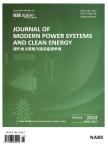Assessment Model for Distributed Wind Generation Hosting Capacity Considering Complex Spatial Correlations
Assessment Model for Distributed Wind Generation Hosting Capacity Considering Complex Spatial Correlations作者机构:IEEE Nanjing Institute of TechnologyNanjing 211167China College of Energy and Electrical Engineering Hohai UniversityNanjing 211100China
出 版 物:《Journal of Modern Power Systems and Clean Energy》 (现代电力系统与清洁能源学报(英文))
年 卷 期:2022年第10卷第5期
页 面:1194-1206页
核心收录:
学科分类:0808[工学-电气工程] 08[工学] 0807[工学-动力工程及工程热物理]
基 金:supported by the National Key Research and Development Program of China (No. 2016YFB0900100) High-level Talents Introduction&Research Start-up Fund Program of Nanjing Institute of Technology (No.YKJ202134)。
主 题:Correlation Benders decomposition(BD) distributed wind generation(DWG) hosting capacity vine copula
摘 要:To facilitate the large-scale integration of distributed wind generation(DWG), the uncertainty of DWG outputs needs to be quantified, and the maximum DWG hosting capacity(DWGHC) of distribution systems must be assessed. However, the structure of the high-dimensional nonlinear dependencies and the abnormal marginal distributions observed in geographically dispersed DWG outputs lead to the increase of the complexity of the uncertainty analysis. To address this issue,this paper proposes a novel assessment model for DWGHC that considers the spatial correlations between distributed generation(DG) outputs. In our method, an advanced dependence modeling approach called vine copula is applied to capture the high-dimensional correlation between geographically dispersed DWG outputs and generate a sufficient number of correlated scenarios. To avoid an overly conservative hosting capacity in some extreme scenarios, a novel chance-constrained assessment model for DWGHC is developed to determine the optimal sizes and locations of DWG for a given DWG curtailment probability. To handle the computational challenges associated with large-scale scenarios, a bilinear variant of Benders decomposition(BD) is employed to solve the chance-constrained problem.The effectiveness of the proposed method is demonstrated using a typical 38-bus distribution system in eastern China.



